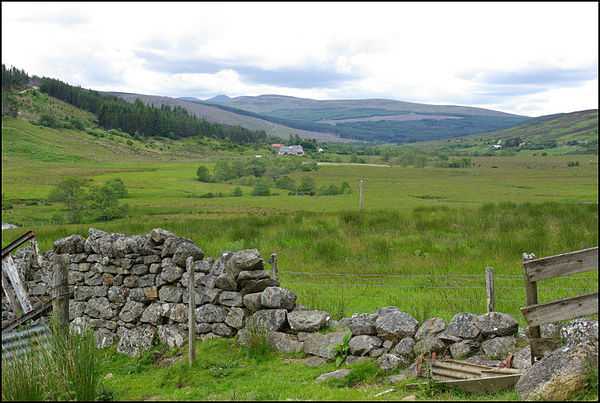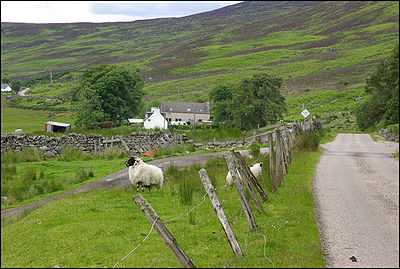Strathrusdale
| Strathrusdale | |
| Scottish Gaelic: Strath Rùsdail | |
 Strathrusdale |
|
| Population | 30 (est.) |
|---|---|
| OS grid reference | NH6174 |
| Council area | Highland |
| Lieutenancy area | Ross and Cromarty |
| Country | Scotland |
| Sovereign state | United Kingdom |
| Post town | Alness |
| Postcode district | IV17 |
| Dialling code | 01349 |
| Police | Scottish |
| Fire | Scottish |
| Ambulance | Scottish |
| EU Parliament | Scotland |
| UK Parliament | Caithness, Sutherland and Easter Ross |
| Scottish Parliament | Ross, Skye and Inverness West |
Coordinates: 57°45′N 4°24′W / 57.75°N 4.40°W
Strathrusdale (Scottish Gaelic/Norse Hybrid: Strath Rùsdail, Strath, [Gaelic] small valley, of Rusdale, rus, Norse for [male sheep] ram, and dale, also small valley)[1] Glen in the Highlands of Scotland forming the western part of the area known as Ardross. The Strath runs east to west for 2.5 miles and the river Blackwater flows through it to merge at the eastern end with another tributary to form the River Alness. The floor of the strath is mainly fields used for sheep grazing. The strath is surrounded by commercial pine forest, except to the north, which is dominated by the mountain Beinn Tharsuinn (2831ft). Traditionally the strath was populated by tenant crofters, however in recent years there has been an increase in the number of new homes and restorations, after many decades of gradual decline.

Strathrusdale looking west[2]
History
Earliest evidence of habitation are still visible in Strathrusdale at the eastern end of the Strath, where there are a number of stone circles, which formed the base of Pictish roundhouses. Picts lived in the area until the 10th century, which was part of the Kingdom of Fortriu. After this period there was progressively more transition as Norse settlement began to increase in the area.
During the late 18th century, great change swept the Highlands when landowners realised that more income could be generated by clearing areas farmed by tenant crofters to make way for sheep. Termed the Highland Clearances, this coincided with a period of great unrest and social upheaval in Europe which unsettled the authorities in Britain.
Strathrusdale became the focus of the clearance policy in 1792 when on the 27th of July the inhabitants of the strath gathered for a wedding in the area where a plot was devised to drive away all the sheep, and by implication all the sheep-farmers. A week later about 400 men from the surrounding districts were driving six thousand sheep towards Beauly.

The sheriff-depute of the county, Donald MacLeod, wrote to the Lord Advocate, asking that a force of the Black Watch be sent north to defeat what MacLeod viewed as open rebellion. The Lord Advocate wrote to the Home Secretary Henry Dundas reporting that sheep farming was very unpopular in the Highlands, as it ‘tended to remove the inhabitants from their small possessions and dwelling houses’. The Home Secretary replied that it was ‘undisputably necessary that the most vigorous and effectual measures should be taken for bringing these daring offenders to punishment’ - and ordered troops north. After a midnight attack on Saturday 6 August by the troops of the Black Watch, the drovers scattered and returned to their crofts. [3] In September, the eight ringleaders of the drive appeared in court at Inverness, charged with ‘advising, exciting, and instigating persons riotously and feloniously to invade, seize upon, and drive away from the grounds of the proprietors flocks of sheep’ and placing the owners ‘at the mercy of a lawless and seditious mob’. Among them were John Ross, a tenant in Strathrusdale, along with his sons Alexander and John Ross, and Donald Munro alias MacAdie and his son William MacAdie. They were all found guilty, two were sentenced to transportation to Botany Bay, while other sentences included life imprisonment, banishment and various terms in gaol. Subsequently, all the prisoners escaped from their captors and disappeared for good despite a £5 reward for each of them.